Operations and Project Management for TESCO: Principles, Lean Six Sigma, and Continuous Improvement
VerifiedAdded on 2023/06/11
|17
|4896
|324
AI Summary
This report discusses the principles of operations and project management applied by TESCO, including lean six sigma and continuous improvement. It covers the implementation of these principles within the organization, their effectiveness in meeting the organization's requirements, and recommendations for improvement. The report also includes an overview of TESCO, its subsidiaries, and its objectives.
Contribute Materials
Your contribution can guide someone’s learning journey. Share your
documents today.
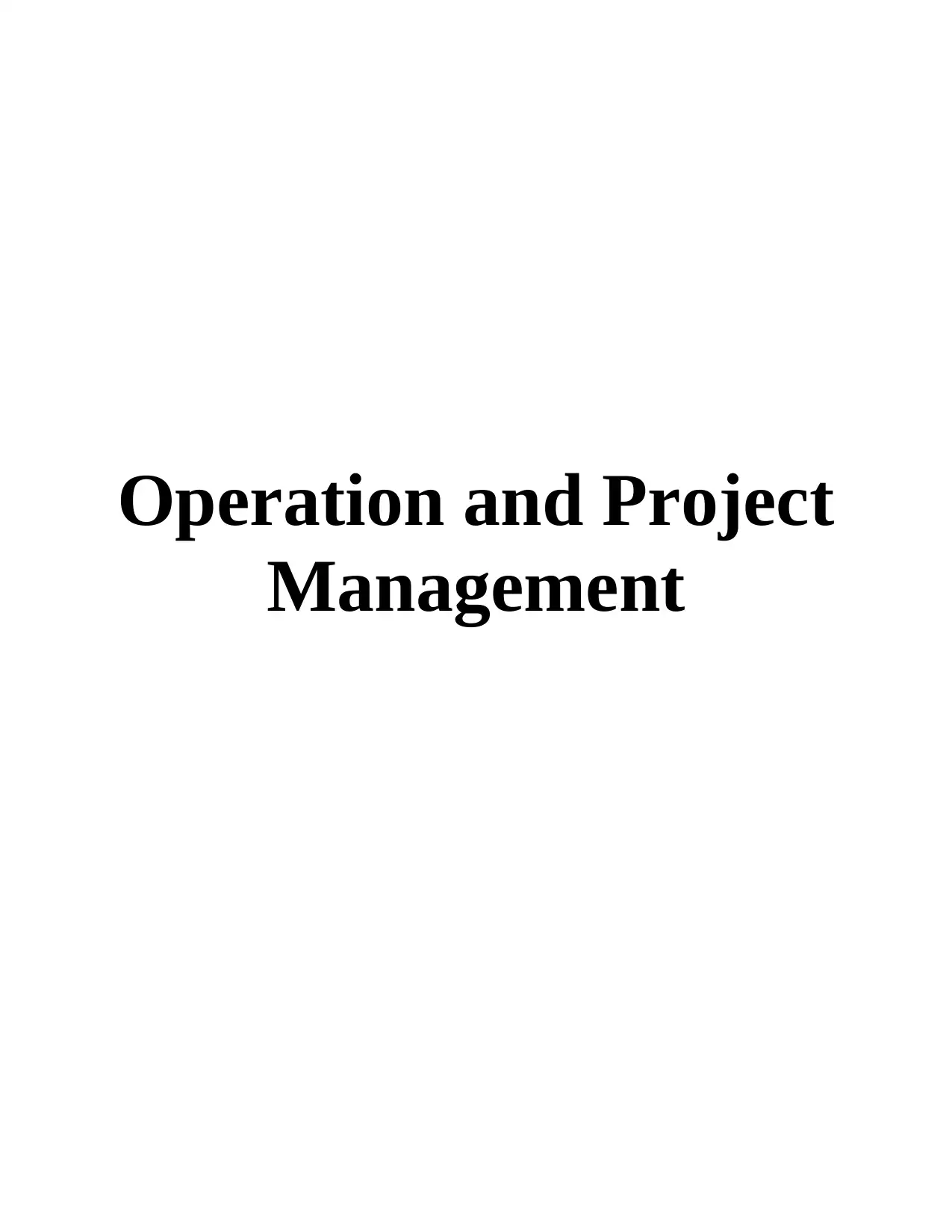
Operation and Project
Management
Management
Secure Best Marks with AI Grader
Need help grading? Try our AI Grader for instant feedback on your assignments.
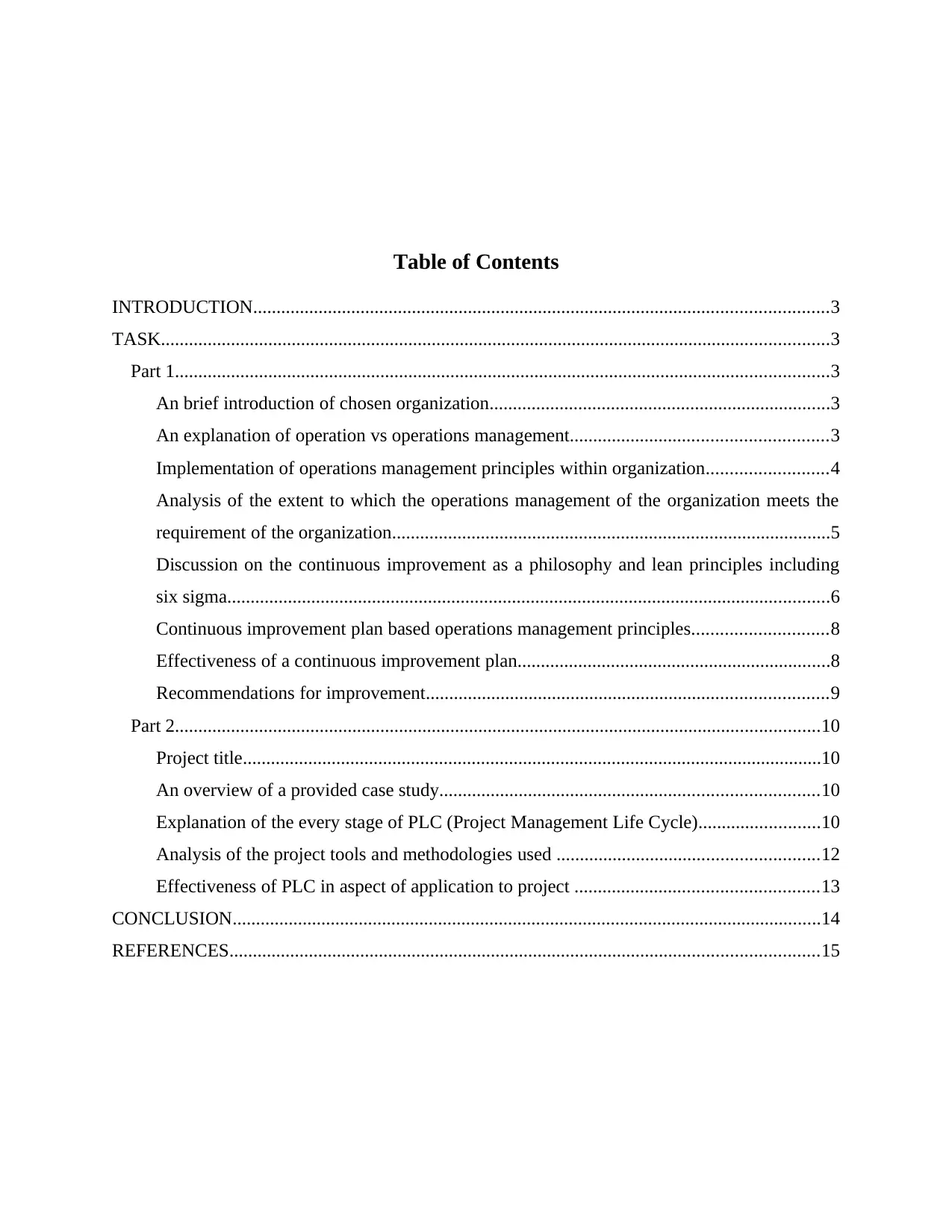
Table of Contents
INTRODUCTION...........................................................................................................................3
TASK...............................................................................................................................................3
Part 1............................................................................................................................................3
An brief introduction of chosen organization.........................................................................3
An explanation of operation vs operations management.......................................................3
Implementation of operations management principles within organization..........................4
Analysis of the extent to which the operations management of the organization meets the
requirement of the organization..............................................................................................5
Discussion on the continuous improvement as a philosophy and lean principles including
six sigma.................................................................................................................................6
Continuous improvement plan based operations management principles.............................8
Effectiveness of a continuous improvement plan...................................................................8
Recommendations for improvement......................................................................................9
Part 2..........................................................................................................................................10
Project title............................................................................................................................10
An overview of a provided case study.................................................................................10
Explanation of the every stage of PLC (Project Management Life Cycle)..........................10
Analysis of the project tools and methodologies used ........................................................12
Effectiveness of PLC in aspect of application to project ....................................................13
CONCLUSION..............................................................................................................................14
REFERENCES..............................................................................................................................15
INTRODUCTION...........................................................................................................................3
TASK...............................................................................................................................................3
Part 1............................................................................................................................................3
An brief introduction of chosen organization.........................................................................3
An explanation of operation vs operations management.......................................................3
Implementation of operations management principles within organization..........................4
Analysis of the extent to which the operations management of the organization meets the
requirement of the organization..............................................................................................5
Discussion on the continuous improvement as a philosophy and lean principles including
six sigma.................................................................................................................................6
Continuous improvement plan based operations management principles.............................8
Effectiveness of a continuous improvement plan...................................................................8
Recommendations for improvement......................................................................................9
Part 2..........................................................................................................................................10
Project title............................................................................................................................10
An overview of a provided case study.................................................................................10
Explanation of the every stage of PLC (Project Management Life Cycle)..........................10
Analysis of the project tools and methodologies used ........................................................12
Effectiveness of PLC in aspect of application to project ....................................................13
CONCLUSION..............................................................................................................................14
REFERENCES..............................................................................................................................15
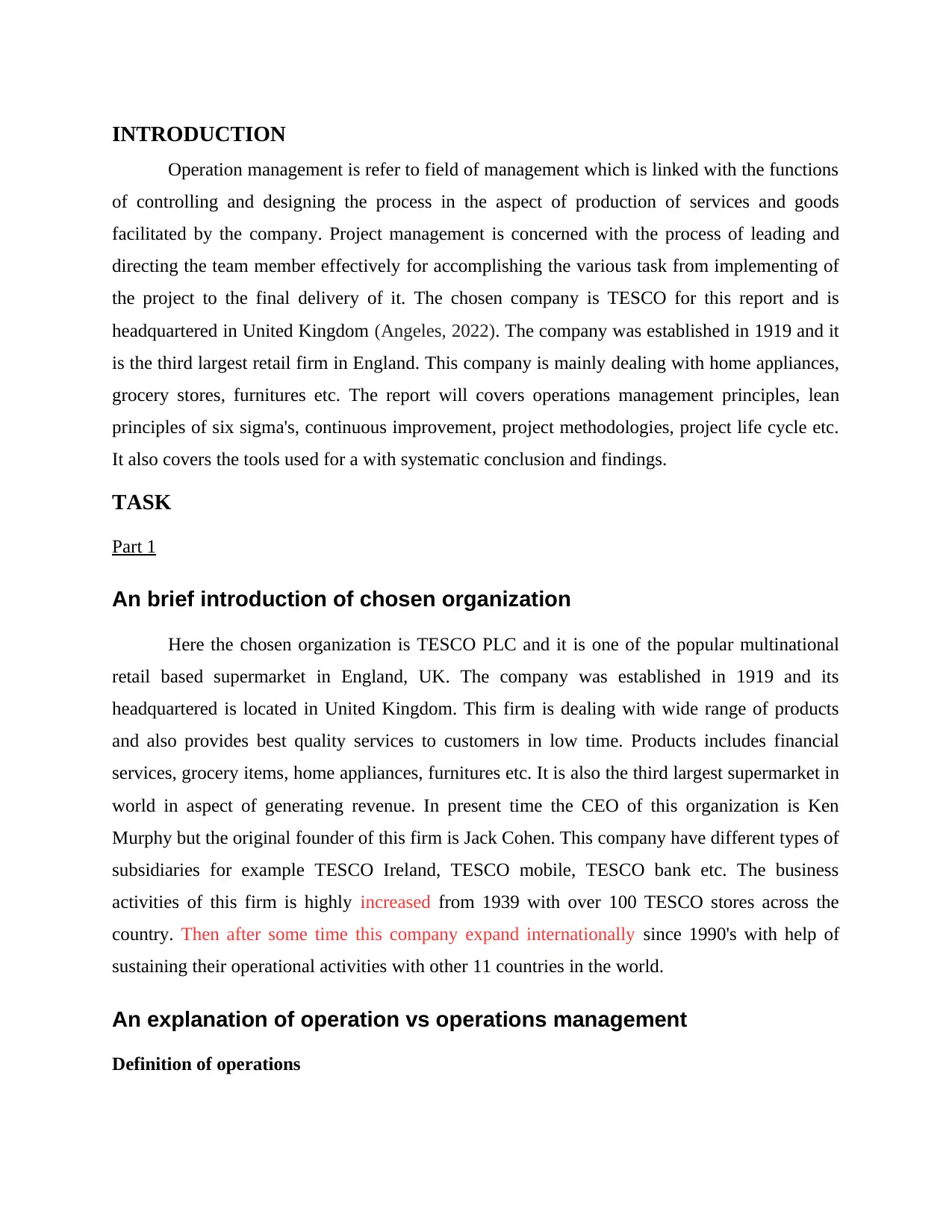
INTRODUCTION
Operation management is refer to field of management which is linked with the functions
of controlling and designing the process in the aspect of production of services and goods
facilitated by the company. Project management is concerned with the process of leading and
directing the team member effectively for accomplishing the various task from implementing of
the project to the final delivery of it. The chosen company is TESCO for this report and is
headquartered in United Kingdom (Angeles, 2022). The company was established in 1919 and it
is the third largest retail firm in England. This company is mainly dealing with home appliances,
grocery stores, furnitures etc. The report will covers operations management principles, lean
principles of six sigma's, continuous improvement, project methodologies, project life cycle etc.
It also covers the tools used for a with systematic conclusion and findings.
TASK
Part 1
An brief introduction of chosen organization
Here the chosen organization is TESCO PLC and it is one of the popular multinational
retail based supermarket in England, UK. The company was established in 1919 and its
headquartered is located in United Kingdom. This firm is dealing with wide range of products
and also provides best quality services to customers in low time. Products includes financial
services, grocery items, home appliances, furnitures etc. It is also the third largest supermarket in
world in aspect of generating revenue. In present time the CEO of this organization is Ken
Murphy but the original founder of this firm is Jack Cohen. This company have different types of
subsidiaries for example TESCO Ireland, TESCO mobile, TESCO bank etc. The business
activities of this firm is highly increased from 1939 with over 100 TESCO stores across the
country. Then after some time this company expand internationally since 1990's with help of
sustaining their operational activities with other 11 countries in the world.
An explanation of operation vs operations management
Definition of operations
Operation management is refer to field of management which is linked with the functions
of controlling and designing the process in the aspect of production of services and goods
facilitated by the company. Project management is concerned with the process of leading and
directing the team member effectively for accomplishing the various task from implementing of
the project to the final delivery of it. The chosen company is TESCO for this report and is
headquartered in United Kingdom (Angeles, 2022). The company was established in 1919 and it
is the third largest retail firm in England. This company is mainly dealing with home appliances,
grocery stores, furnitures etc. The report will covers operations management principles, lean
principles of six sigma's, continuous improvement, project methodologies, project life cycle etc.
It also covers the tools used for a with systematic conclusion and findings.
TASK
Part 1
An brief introduction of chosen organization
Here the chosen organization is TESCO PLC and it is one of the popular multinational
retail based supermarket in England, UK. The company was established in 1919 and its
headquartered is located in United Kingdom. This firm is dealing with wide range of products
and also provides best quality services to customers in low time. Products includes financial
services, grocery items, home appliances, furnitures etc. It is also the third largest supermarket in
world in aspect of generating revenue. In present time the CEO of this organization is Ken
Murphy but the original founder of this firm is Jack Cohen. This company have different types of
subsidiaries for example TESCO Ireland, TESCO mobile, TESCO bank etc. The business
activities of this firm is highly increased from 1939 with over 100 TESCO stores across the
country. Then after some time this company expand internationally since 1990's with help of
sustaining their operational activities with other 11 countries in the world.
An explanation of operation vs operations management
Definition of operations
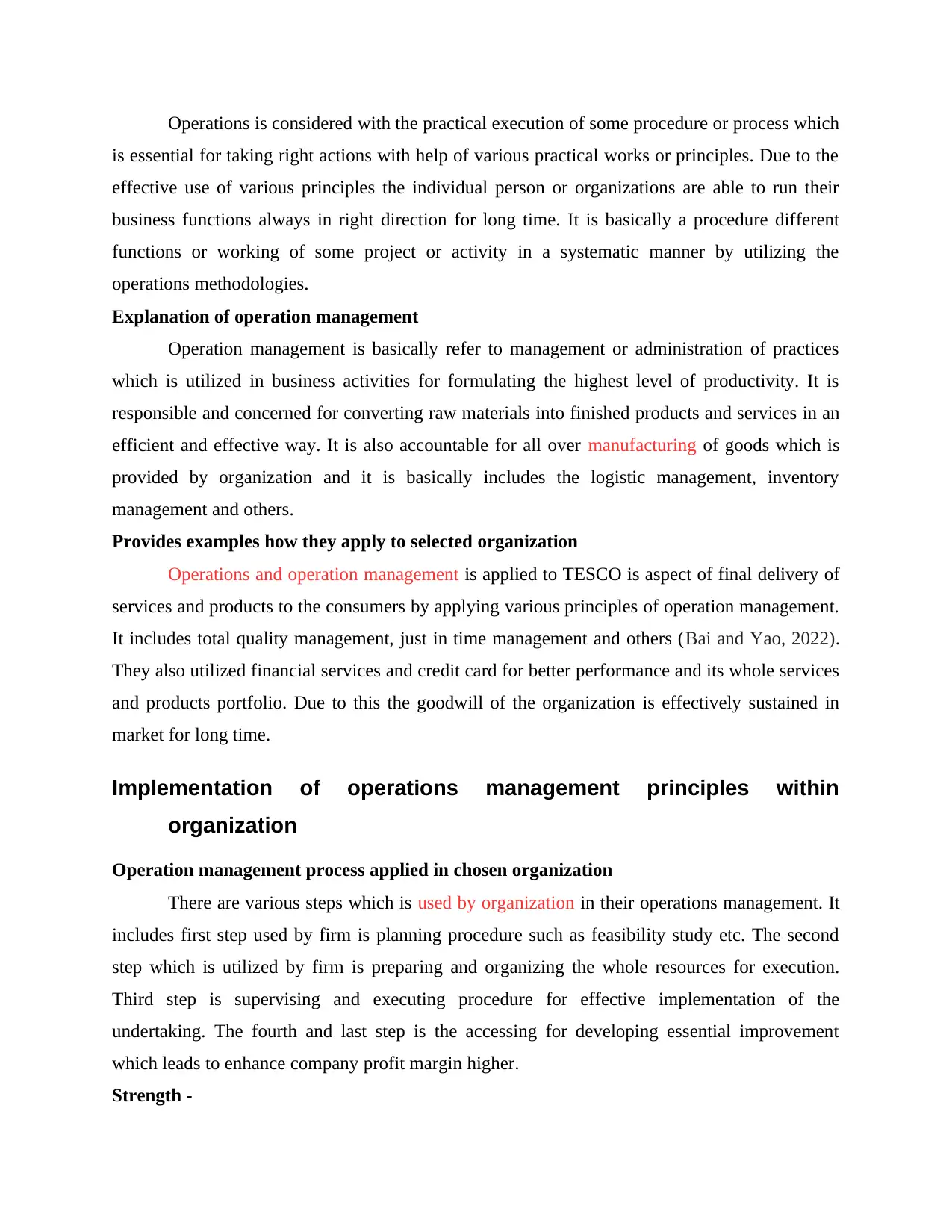
Operations is considered with the practical execution of some procedure or process which
is essential for taking right actions with help of various practical works or principles. Due to the
effective use of various principles the individual person or organizations are able to run their
business functions always in right direction for long time. It is basically a procedure different
functions or working of some project or activity in a systematic manner by utilizing the
operations methodologies.
Explanation of operation management
Operation management is basically refer to management or administration of practices
which is utilized in business activities for formulating the highest level of productivity. It is
responsible and concerned for converting raw materials into finished products and services in an
efficient and effective way. It is also accountable for all over manufacturing of goods which is
provided by organization and it is basically includes the logistic management, inventory
management and others.
Provides examples how they apply to selected organization
Operations and operation management is applied to TESCO is aspect of final delivery of
services and products to the consumers by applying various principles of operation management.
It includes total quality management, just in time management and others (Bai and Yao, 2022).
They also utilized financial services and credit card for better performance and its whole services
and products portfolio. Due to this the goodwill of the organization is effectively sustained in
market for long time.
Implementation of operations management principles within
organization
Operation management process applied in chosen organization
There are various steps which is used by organization in their operations management. It
includes first step used by firm is planning procedure such as feasibility study etc. The second
step which is utilized by firm is preparing and organizing the whole resources for execution.
Third step is supervising and executing procedure for effective implementation of the
undertaking. The fourth and last step is the accessing for developing essential improvement
which leads to enhance company profit margin higher.
Strength -
is essential for taking right actions with help of various practical works or principles. Due to the
effective use of various principles the individual person or organizations are able to run their
business functions always in right direction for long time. It is basically a procedure different
functions or working of some project or activity in a systematic manner by utilizing the
operations methodologies.
Explanation of operation management
Operation management is basically refer to management or administration of practices
which is utilized in business activities for formulating the highest level of productivity. It is
responsible and concerned for converting raw materials into finished products and services in an
efficient and effective way. It is also accountable for all over manufacturing of goods which is
provided by organization and it is basically includes the logistic management, inventory
management and others.
Provides examples how they apply to selected organization
Operations and operation management is applied to TESCO is aspect of final delivery of
services and products to the consumers by applying various principles of operation management.
It includes total quality management, just in time management and others (Bai and Yao, 2022).
They also utilized financial services and credit card for better performance and its whole services
and products portfolio. Due to this the goodwill of the organization is effectively sustained in
market for long time.
Implementation of operations management principles within
organization
Operation management process applied in chosen organization
There are various steps which is used by organization in their operations management. It
includes first step used by firm is planning procedure such as feasibility study etc. The second
step which is utilized by firm is preparing and organizing the whole resources for execution.
Third step is supervising and executing procedure for effective implementation of the
undertaking. The fourth and last step is the accessing for developing essential improvement
which leads to enhance company profit margin higher.
Strength -
Secure Best Marks with AI Grader
Need help grading? Try our AI Grader for instant feedback on your assignments.
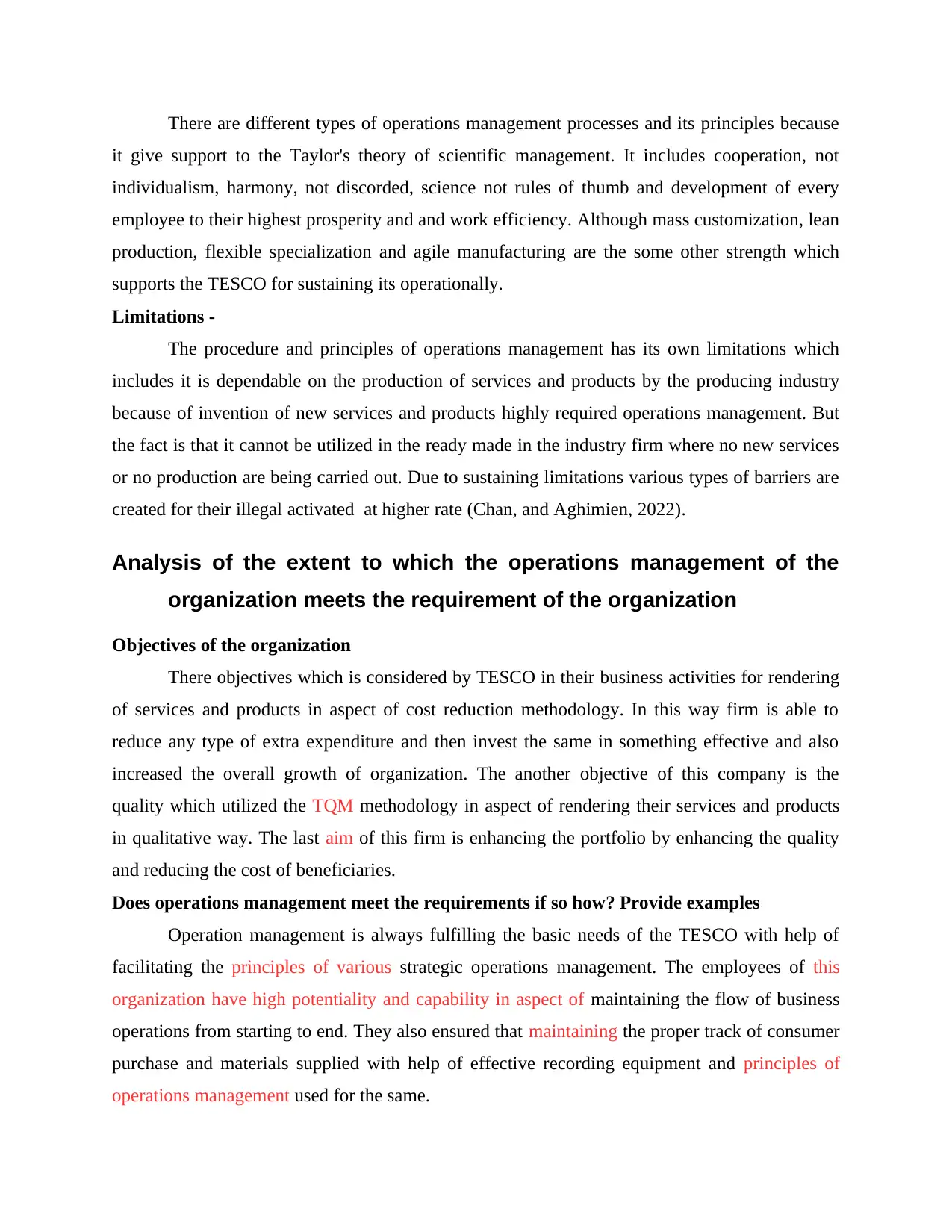
There are different types of operations management processes and its principles because
it give support to the Taylor's theory of scientific management. It includes cooperation, not
individualism, harmony, not discorded, science not rules of thumb and development of every
employee to their highest prosperity and and work efficiency. Although mass customization, lean
production, flexible specialization and agile manufacturing are the some other strength which
supports the TESCO for sustaining its operationally.
Limitations -
The procedure and principles of operations management has its own limitations which
includes it is dependable on the production of services and products by the producing industry
because of invention of new services and products highly required operations management. But
the fact is that it cannot be utilized in the ready made in the industry firm where no new services
or no production are being carried out. Due to sustaining limitations various types of barriers are
created for their illegal activated at higher rate (Chan, and Aghimien, 2022).
Analysis of the extent to which the operations management of the
organization meets the requirement of the organization
Objectives of the organization
There objectives which is considered by TESCO in their business activities for rendering
of services and products in aspect of cost reduction methodology. In this way firm is able to
reduce any type of extra expenditure and then invest the same in something effective and also
increased the overall growth of organization. The another objective of this company is the
quality which utilized the TQM methodology in aspect of rendering their services and products
in qualitative way. The last aim of this firm is enhancing the portfolio by enhancing the quality
and reducing the cost of beneficiaries.
Does operations management meet the requirements if so how? Provide examples
Operation management is always fulfilling the basic needs of the TESCO with help of
facilitating the principles of various strategic operations management. The employees of this
organization have high potentiality and capability in aspect of maintaining the flow of business
operations from starting to end. They also ensured that maintaining the proper track of consumer
purchase and materials supplied with help of effective recording equipment and principles of
operations management used for the same.
it give support to the Taylor's theory of scientific management. It includes cooperation, not
individualism, harmony, not discorded, science not rules of thumb and development of every
employee to their highest prosperity and and work efficiency. Although mass customization, lean
production, flexible specialization and agile manufacturing are the some other strength which
supports the TESCO for sustaining its operationally.
Limitations -
The procedure and principles of operations management has its own limitations which
includes it is dependable on the production of services and products by the producing industry
because of invention of new services and products highly required operations management. But
the fact is that it cannot be utilized in the ready made in the industry firm where no new services
or no production are being carried out. Due to sustaining limitations various types of barriers are
created for their illegal activated at higher rate (Chan, and Aghimien, 2022).
Analysis of the extent to which the operations management of the
organization meets the requirement of the organization
Objectives of the organization
There objectives which is considered by TESCO in their business activities for rendering
of services and products in aspect of cost reduction methodology. In this way firm is able to
reduce any type of extra expenditure and then invest the same in something effective and also
increased the overall growth of organization. The another objective of this company is the
quality which utilized the TQM methodology in aspect of rendering their services and products
in qualitative way. The last aim of this firm is enhancing the portfolio by enhancing the quality
and reducing the cost of beneficiaries.
Does operations management meet the requirements if so how? Provide examples
Operation management is always fulfilling the basic needs of the TESCO with help of
facilitating the principles of various strategic operations management. The employees of this
organization have high potentiality and capability in aspect of maintaining the flow of business
operations from starting to end. They also ensured that maintaining the proper track of consumer
purchase and materials supplied with help of effective recording equipment and principles of
operations management used for the same.
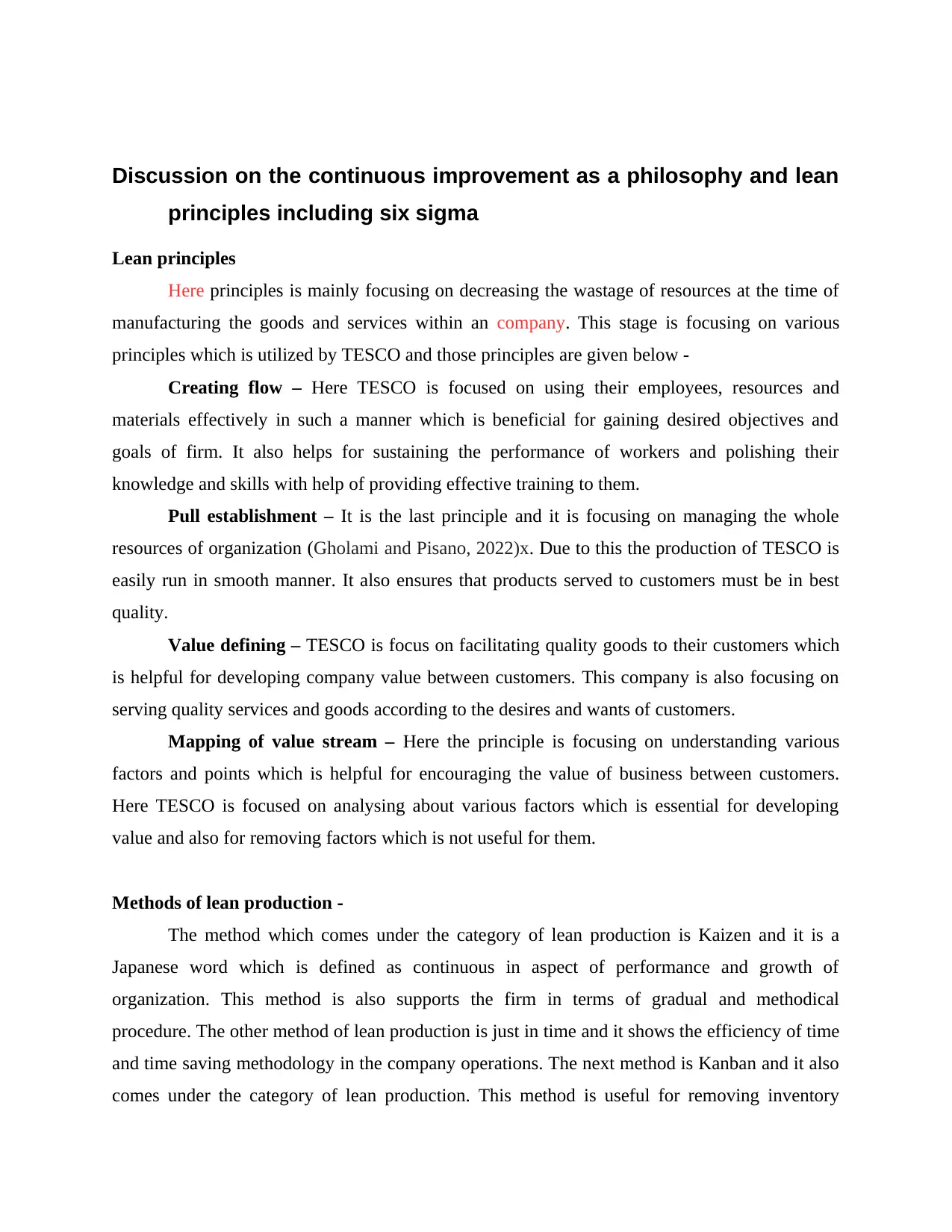
Discussion on the continuous improvement as a philosophy and lean
principles including six sigma
Lean principles
Here principles is mainly focusing on decreasing the wastage of resources at the time of
manufacturing the goods and services within an company. This stage is focusing on various
principles which is utilized by TESCO and those principles are given below -
Creating flow – Here TESCO is focused on using their employees, resources and
materials effectively in such a manner which is beneficial for gaining desired objectives and
goals of firm. It also helps for sustaining the performance of workers and polishing their
knowledge and skills with help of providing effective training to them.
Pull establishment – It is the last principle and it is focusing on managing the whole
resources of organization (Gholami and Pisano, 2022)x. Due to this the production of TESCO is
easily run in smooth manner. It also ensures that products served to customers must be in best
quality.
Value defining – TESCO is focus on facilitating quality goods to their customers which
is helpful for developing company value between customers. This company is also focusing on
serving quality services and goods according to the desires and wants of customers.
Mapping of value stream – Here the principle is focusing on understanding various
factors and points which is helpful for encouraging the value of business between customers.
Here TESCO is focused on analysing about various factors which is essential for developing
value and also for removing factors which is not useful for them.
Methods of lean production -
The method which comes under the category of lean production is Kaizen and it is a
Japanese word which is defined as continuous in aspect of performance and growth of
organization. This method is also supports the firm in terms of gradual and methodical
procedure. The other method of lean production is just in time and it shows the efficiency of time
and time saving methodology in the company operations. The next method is Kanban and it also
comes under the category of lean production. This method is useful for removing inventory
principles including six sigma
Lean principles
Here principles is mainly focusing on decreasing the wastage of resources at the time of
manufacturing the goods and services within an company. This stage is focusing on various
principles which is utilized by TESCO and those principles are given below -
Creating flow – Here TESCO is focused on using their employees, resources and
materials effectively in such a manner which is beneficial for gaining desired objectives and
goals of firm. It also helps for sustaining the performance of workers and polishing their
knowledge and skills with help of providing effective training to them.
Pull establishment – It is the last principle and it is focusing on managing the whole
resources of organization (Gholami and Pisano, 2022)x. Due to this the production of TESCO is
easily run in smooth manner. It also ensures that products served to customers must be in best
quality.
Value defining – TESCO is focus on facilitating quality goods to their customers which
is helpful for developing company value between customers. This company is also focusing on
serving quality services and goods according to the desires and wants of customers.
Mapping of value stream – Here the principle is focusing on understanding various
factors and points which is helpful for encouraging the value of business between customers.
Here TESCO is focused on analysing about various factors which is essential for developing
value and also for removing factors which is not useful for them.
Methods of lean production -
The method which comes under the category of lean production is Kaizen and it is a
Japanese word which is defined as continuous in aspect of performance and growth of
organization. This method is also supports the firm in terms of gradual and methodical
procedure. The other method of lean production is just in time and it shows the efficiency of time
and time saving methodology in the company operations. The next method is Kanban and it also
comes under the category of lean production. This method is useful for removing inventory
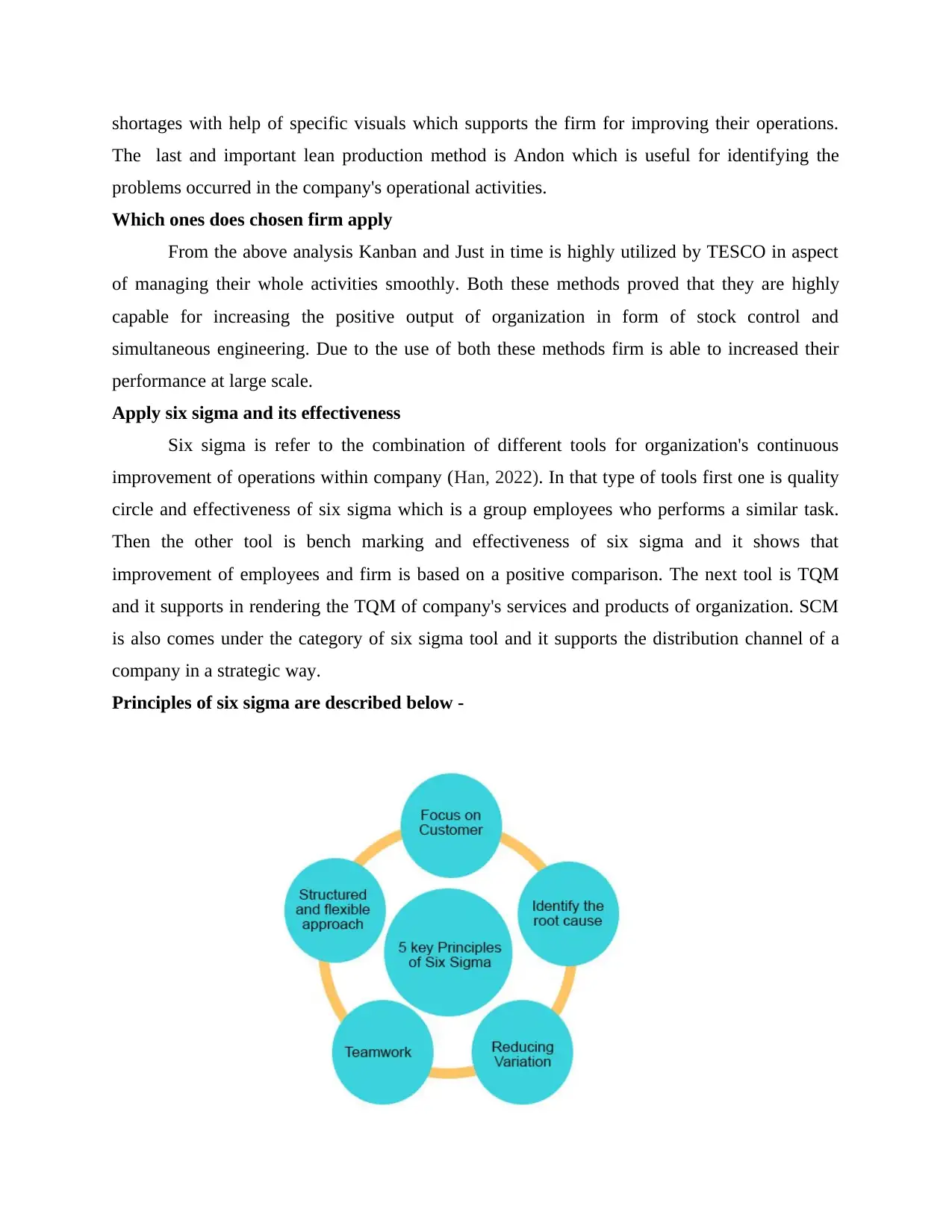
shortages with help of specific visuals which supports the firm for improving their operations.
The last and important lean production method is Andon which is useful for identifying the
problems occurred in the company's operational activities.
Which ones does chosen firm apply
From the above analysis Kanban and Just in time is highly utilized by TESCO in aspect
of managing their whole activities smoothly. Both these methods proved that they are highly
capable for increasing the positive output of organization in form of stock control and
simultaneous engineering. Due to the use of both these methods firm is able to increased their
performance at large scale.
Apply six sigma and its effectiveness
Six sigma is refer to the combination of different tools for organization's continuous
improvement of operations within company (Han, 2022). In that type of tools first one is quality
circle and effectiveness of six sigma which is a group employees who performs a similar task.
Then the other tool is bench marking and effectiveness of six sigma and it shows that
improvement of employees and firm is based on a positive comparison. The next tool is TQM
and it supports in rendering the TQM of company's services and products of organization. SCM
is also comes under the category of six sigma tool and it supports the distribution channel of a
company in a strategic way.
Principles of six sigma are described below -
The last and important lean production method is Andon which is useful for identifying the
problems occurred in the company's operational activities.
Which ones does chosen firm apply
From the above analysis Kanban and Just in time is highly utilized by TESCO in aspect
of managing their whole activities smoothly. Both these methods proved that they are highly
capable for increasing the positive output of organization in form of stock control and
simultaneous engineering. Due to the use of both these methods firm is able to increased their
performance at large scale.
Apply six sigma and its effectiveness
Six sigma is refer to the combination of different tools for organization's continuous
improvement of operations within company (Han, 2022). In that type of tools first one is quality
circle and effectiveness of six sigma which is a group employees who performs a similar task.
Then the other tool is bench marking and effectiveness of six sigma and it shows that
improvement of employees and firm is based on a positive comparison. The next tool is TQM
and it supports in rendering the TQM of company's services and products of organization. SCM
is also comes under the category of six sigma tool and it supports the distribution channel of a
company in a strategic way.
Principles of six sigma are described below -
Paraphrase This Document
Need a fresh take? Get an instant paraphrase of this document with our AI Paraphraser
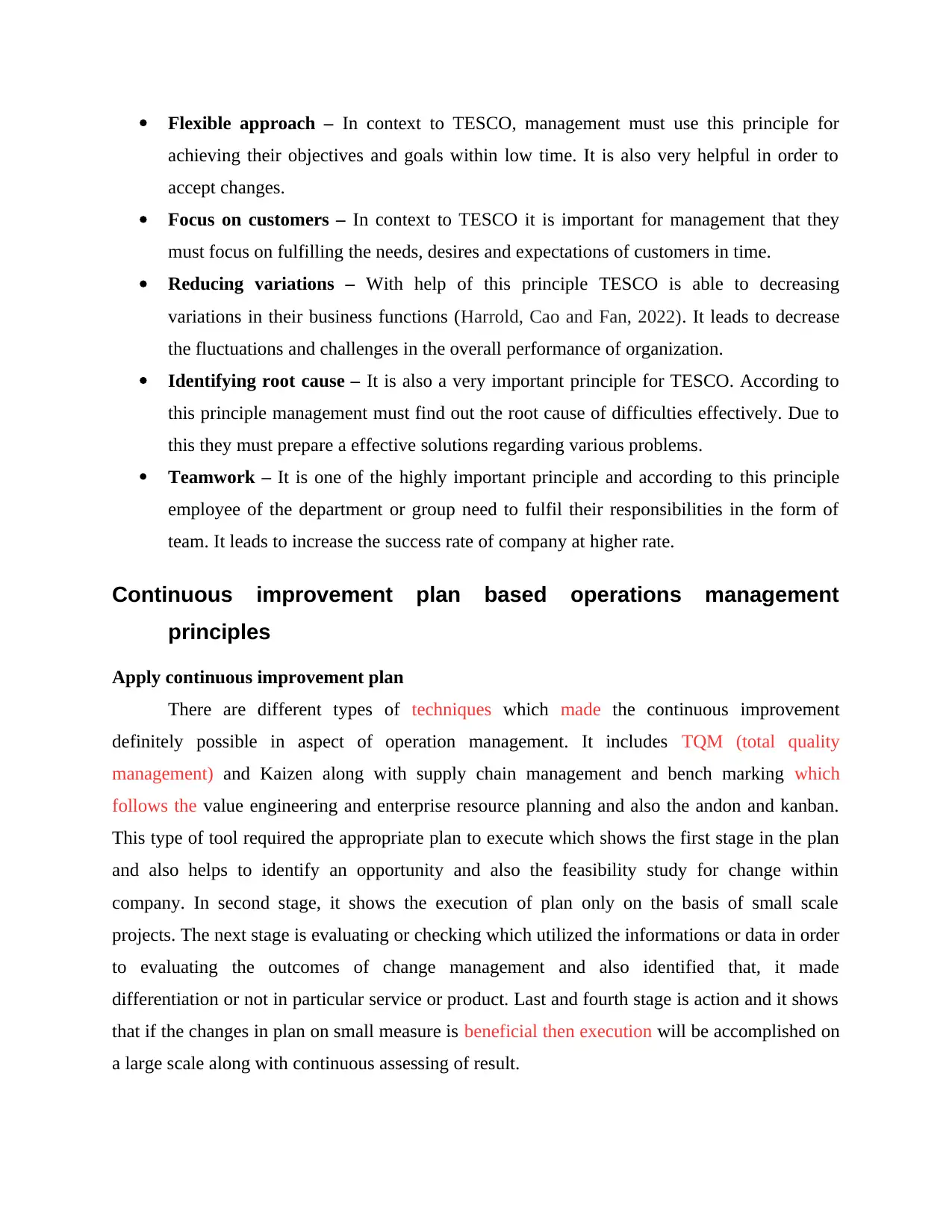
Flexible approach – In context to TESCO, management must use this principle for
achieving their objectives and goals within low time. It is also very helpful in order to
accept changes.
Focus on customers – In context to TESCO it is important for management that they
must focus on fulfilling the needs, desires and expectations of customers in time.
Reducing variations – With help of this principle TESCO is able to decreasing
variations in their business functions (Harrold, Cao and Fan, 2022). It leads to decrease
the fluctuations and challenges in the overall performance of organization.
Identifying root cause – It is also a very important principle for TESCO. According to
this principle management must find out the root cause of difficulties effectively. Due to
this they must prepare a effective solutions regarding various problems.
Teamwork – It is one of the highly important principle and according to this principle
employee of the department or group need to fulfil their responsibilities in the form of
team. It leads to increase the success rate of company at higher rate.
Continuous improvement plan based operations management
principles
Apply continuous improvement plan
There are different types of techniques which made the continuous improvement
definitely possible in aspect of operation management. It includes TQM (total quality
management) and Kaizen along with supply chain management and bench marking which
follows the value engineering and enterprise resource planning and also the andon and kanban.
This type of tool required the appropriate plan to execute which shows the first stage in the plan
and also helps to identify an opportunity and also the feasibility study for change within
company. In second stage, it shows the execution of plan only on the basis of small scale
projects. The next stage is evaluating or checking which utilized the informations or data in order
to evaluating the outcomes of change management and also identified that, it made
differentiation or not in particular service or product. Last and fourth stage is action and it shows
that if the changes in plan on small measure is beneficial then execution will be accomplished on
a large scale along with continuous assessing of result.
achieving their objectives and goals within low time. It is also very helpful in order to
accept changes.
Focus on customers – In context to TESCO it is important for management that they
must focus on fulfilling the needs, desires and expectations of customers in time.
Reducing variations – With help of this principle TESCO is able to decreasing
variations in their business functions (Harrold, Cao and Fan, 2022). It leads to decrease
the fluctuations and challenges in the overall performance of organization.
Identifying root cause – It is also a very important principle for TESCO. According to
this principle management must find out the root cause of difficulties effectively. Due to
this they must prepare a effective solutions regarding various problems.
Teamwork – It is one of the highly important principle and according to this principle
employee of the department or group need to fulfil their responsibilities in the form of
team. It leads to increase the success rate of company at higher rate.
Continuous improvement plan based operations management
principles
Apply continuous improvement plan
There are different types of techniques which made the continuous improvement
definitely possible in aspect of operation management. It includes TQM (total quality
management) and Kaizen along with supply chain management and bench marking which
follows the value engineering and enterprise resource planning and also the andon and kanban.
This type of tool required the appropriate plan to execute which shows the first stage in the plan
and also helps to identify an opportunity and also the feasibility study for change within
company. In second stage, it shows the execution of plan only on the basis of small scale
projects. The next stage is evaluating or checking which utilized the informations or data in order
to evaluating the outcomes of change management and also identified that, it made
differentiation or not in particular service or product. Last and fourth stage is action and it shows
that if the changes in plan on small measure is beneficial then execution will be accomplished on
a large scale along with continuous assessing of result.
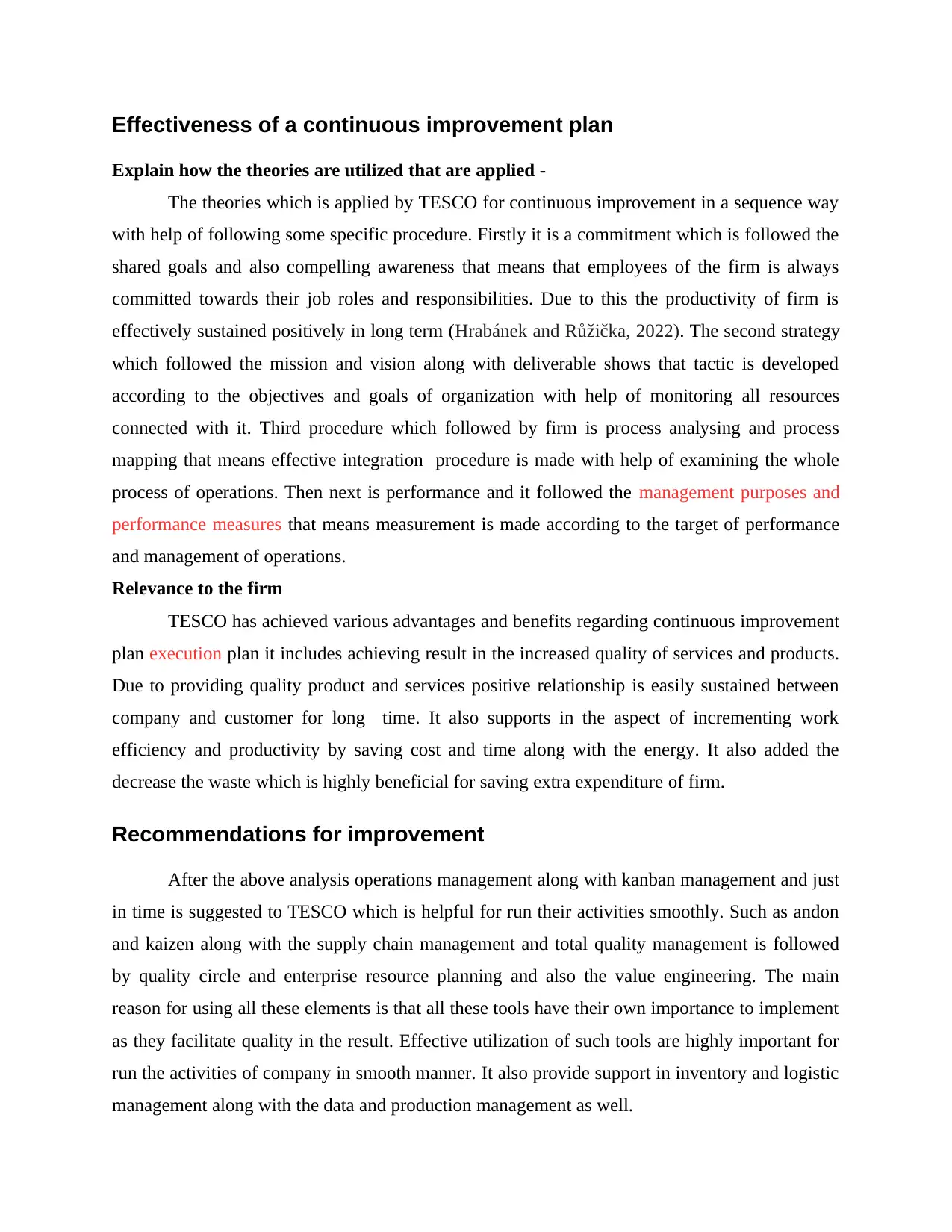
Effectiveness of a continuous improvement plan
Explain how the theories are utilized that are applied -
The theories which is applied by TESCO for continuous improvement in a sequence way
with help of following some specific procedure. Firstly it is a commitment which is followed the
shared goals and also compelling awareness that means that employees of the firm is always
committed towards their job roles and responsibilities. Due to this the productivity of firm is
effectively sustained positively in long term (Hrabánek and Růžička, 2022). The second strategy
which followed the mission and vision along with deliverable shows that tactic is developed
according to the objectives and goals of organization with help of monitoring all resources
connected with it. Third procedure which followed by firm is process analysing and process
mapping that means effective integration procedure is made with help of examining the whole
process of operations. Then next is performance and it followed the management purposes and
performance measures that means measurement is made according to the target of performance
and management of operations.
Relevance to the firm
TESCO has achieved various advantages and benefits regarding continuous improvement
plan execution plan it includes achieving result in the increased quality of services and products.
Due to providing quality product and services positive relationship is easily sustained between
company and customer for long time. It also supports in the aspect of incrementing work
efficiency and productivity by saving cost and time along with the energy. It also added the
decrease the waste which is highly beneficial for saving extra expenditure of firm.
Recommendations for improvement
After the above analysis operations management along with kanban management and just
in time is suggested to TESCO which is helpful for run their activities smoothly. Such as andon
and kaizen along with the supply chain management and total quality management is followed
by quality circle and enterprise resource planning and also the value engineering. The main
reason for using all these elements is that all these tools have their own importance to implement
as they facilitate quality in the result. Effective utilization of such tools are highly important for
run the activities of company in smooth manner. It also provide support in inventory and logistic
management along with the data and production management as well.
Explain how the theories are utilized that are applied -
The theories which is applied by TESCO for continuous improvement in a sequence way
with help of following some specific procedure. Firstly it is a commitment which is followed the
shared goals and also compelling awareness that means that employees of the firm is always
committed towards their job roles and responsibilities. Due to this the productivity of firm is
effectively sustained positively in long term (Hrabánek and Růžička, 2022). The second strategy
which followed the mission and vision along with deliverable shows that tactic is developed
according to the objectives and goals of organization with help of monitoring all resources
connected with it. Third procedure which followed by firm is process analysing and process
mapping that means effective integration procedure is made with help of examining the whole
process of operations. Then next is performance and it followed the management purposes and
performance measures that means measurement is made according to the target of performance
and management of operations.
Relevance to the firm
TESCO has achieved various advantages and benefits regarding continuous improvement
plan execution plan it includes achieving result in the increased quality of services and products.
Due to providing quality product and services positive relationship is easily sustained between
company and customer for long time. It also supports in the aspect of incrementing work
efficiency and productivity by saving cost and time along with the energy. It also added the
decrease the waste which is highly beneficial for saving extra expenditure of firm.
Recommendations for improvement
After the above analysis operations management along with kanban management and just
in time is suggested to TESCO which is helpful for run their activities smoothly. Such as andon
and kaizen along with the supply chain management and total quality management is followed
by quality circle and enterprise resource planning and also the value engineering. The main
reason for using all these elements is that all these tools have their own importance to implement
as they facilitate quality in the result. Effective utilization of such tools are highly important for
run the activities of company in smooth manner. It also provide support in inventory and logistic
management along with the data and production management as well.
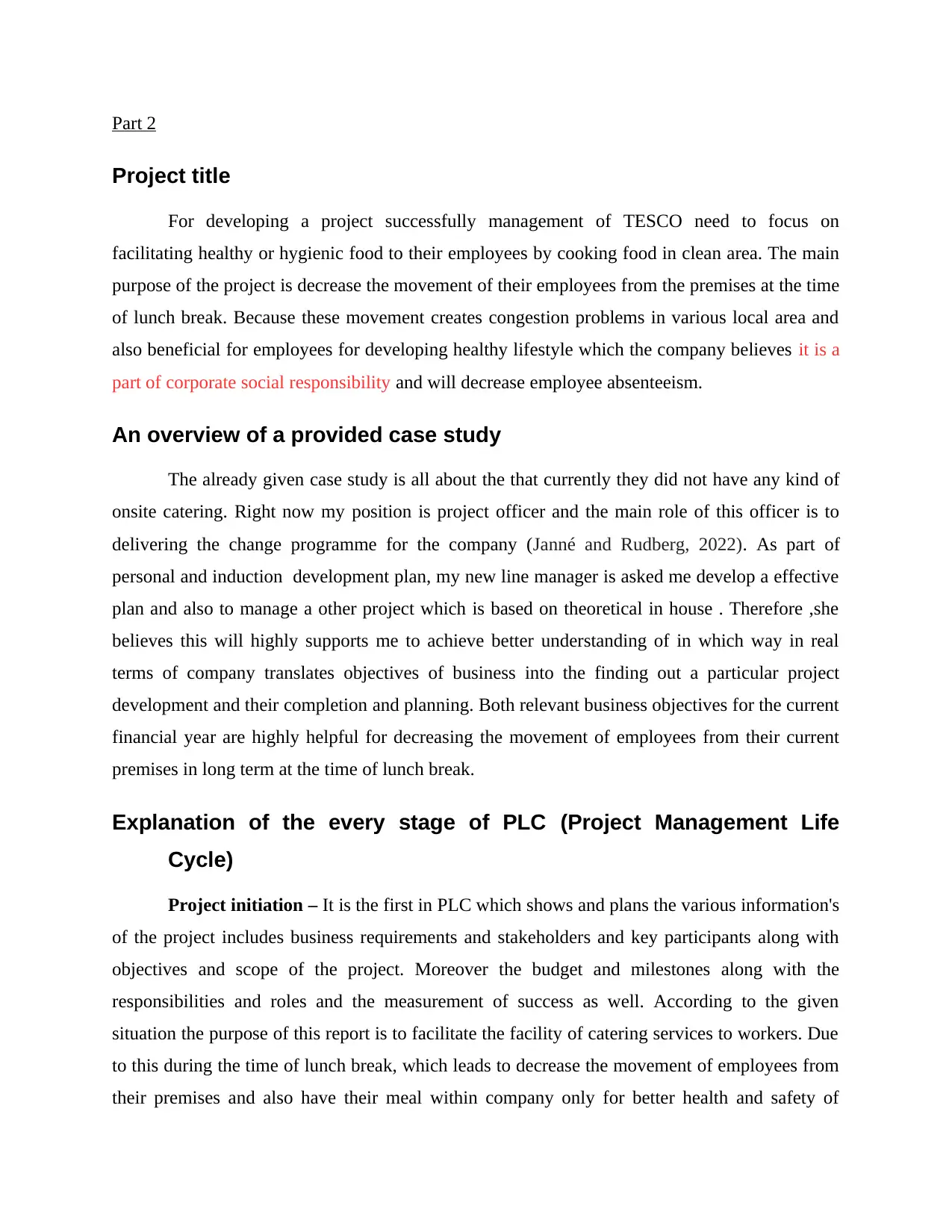
Part 2
Project title
For developing a project successfully management of TESCO need to focus on
facilitating healthy or hygienic food to their employees by cooking food in clean area. The main
purpose of the project is decrease the movement of their employees from the premises at the time
of lunch break. Because these movement creates congestion problems in various local area and
also beneficial for employees for developing healthy lifestyle which the company believes it is a
part of corporate social responsibility and will decrease employee absenteeism.
An overview of a provided case study
The already given case study is all about the that currently they did not have any kind of
onsite catering. Right now my position is project officer and the main role of this officer is to
delivering the change programme for the company (Janné and Rudberg, 2022). As part of
personal and induction development plan, my new line manager is asked me develop a effective
plan and also to manage a other project which is based on theoretical in house . Therefore ,she
believes this will highly supports me to achieve better understanding of in which way in real
terms of company translates objectives of business into the finding out a particular project
development and their completion and planning. Both relevant business objectives for the current
financial year are highly helpful for decreasing the movement of employees from their current
premises in long term at the time of lunch break.
Explanation of the every stage of PLC (Project Management Life
Cycle)
Project initiation – It is the first in PLC which shows and plans the various information's
of the project includes business requirements and stakeholders and key participants along with
objectives and scope of the project. Moreover the budget and milestones along with the
responsibilities and roles and the measurement of success as well. According to the given
situation the purpose of this report is to facilitate the facility of catering services to workers. Due
to this during the time of lunch break, which leads to decrease the movement of employees from
their premises and also have their meal within company only for better health and safety of
Project title
For developing a project successfully management of TESCO need to focus on
facilitating healthy or hygienic food to their employees by cooking food in clean area. The main
purpose of the project is decrease the movement of their employees from the premises at the time
of lunch break. Because these movement creates congestion problems in various local area and
also beneficial for employees for developing healthy lifestyle which the company believes it is a
part of corporate social responsibility and will decrease employee absenteeism.
An overview of a provided case study
The already given case study is all about the that currently they did not have any kind of
onsite catering. Right now my position is project officer and the main role of this officer is to
delivering the change programme for the company (Janné and Rudberg, 2022). As part of
personal and induction development plan, my new line manager is asked me develop a effective
plan and also to manage a other project which is based on theoretical in house . Therefore ,she
believes this will highly supports me to achieve better understanding of in which way in real
terms of company translates objectives of business into the finding out a particular project
development and their completion and planning. Both relevant business objectives for the current
financial year are highly helpful for decreasing the movement of employees from their current
premises in long term at the time of lunch break.
Explanation of the every stage of PLC (Project Management Life
Cycle)
Project initiation – It is the first in PLC which shows and plans the various information's
of the project includes business requirements and stakeholders and key participants along with
objectives and scope of the project. Moreover the budget and milestones along with the
responsibilities and roles and the measurement of success as well. According to the given
situation the purpose of this report is to facilitate the facility of catering services to workers. Due
to this during the time of lunch break, which leads to decrease the movement of employees from
their premises and also have their meal within company only for better health and safety of
Secure Best Marks with AI Grader
Need help grading? Try our AI Grader for instant feedback on your assignments.
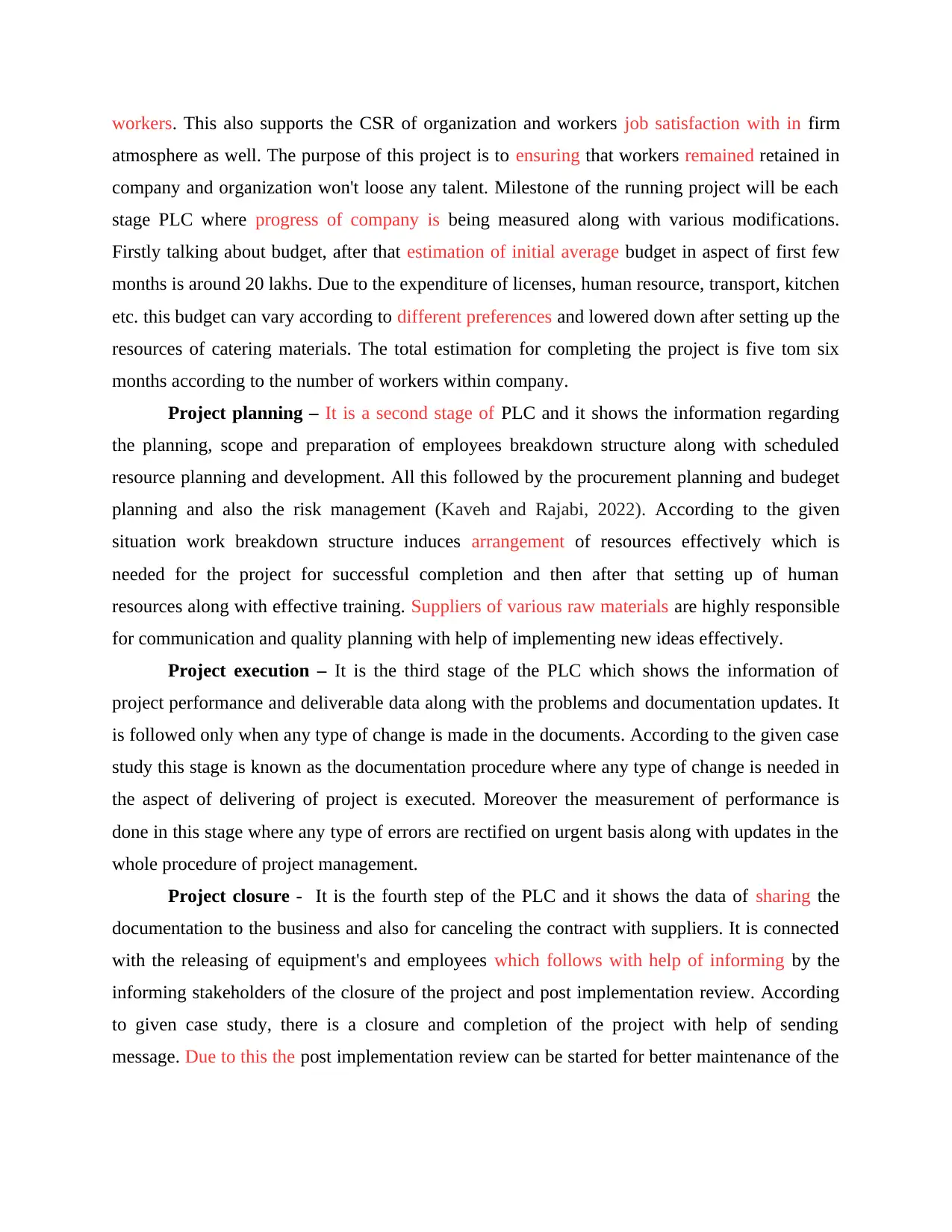
workers. This also supports the CSR of organization and workers job satisfaction with in firm
atmosphere as well. The purpose of this project is to ensuring that workers remained retained in
company and organization won't loose any talent. Milestone of the running project will be each
stage PLC where progress of company is being measured along with various modifications.
Firstly talking about budget, after that estimation of initial average budget in aspect of first few
months is around 20 lakhs. Due to the expenditure of licenses, human resource, transport, kitchen
etc. this budget can vary according to different preferences and lowered down after setting up the
resources of catering materials. The total estimation for completing the project is five tom six
months according to the number of workers within company.
Project planning – It is a second stage of PLC and it shows the information regarding
the planning, scope and preparation of employees breakdown structure along with scheduled
resource planning and development. All this followed by the procurement planning and budeget
planning and also the risk management (Kaveh and Rajabi, 2022). According to the given
situation work breakdown structure induces arrangement of resources effectively which is
needed for the project for successful completion and then after that setting up of human
resources along with effective training. Suppliers of various raw materials are highly responsible
for communication and quality planning with help of implementing new ideas effectively.
Project execution – It is the third stage of the PLC which shows the information of
project performance and deliverable data along with the problems and documentation updates. It
is followed only when any type of change is made in the documents. According to the given case
study this stage is known as the documentation procedure where any type of change is needed in
the aspect of delivering of project is executed. Moreover the measurement of performance is
done in this stage where any type of errors are rectified on urgent basis along with updates in the
whole procedure of project management.
Project closure - It is the fourth step of the PLC and it shows the data of sharing the
documentation to the business and also for canceling the contract with suppliers. It is connected
with the releasing of equipment's and employees which follows with help of informing by the
informing stakeholders of the closure of the project and post implementation review. According
to given case study, there is a closure and completion of the project with help of sending
message. Due to this the post implementation review can be started for better maintenance of the
atmosphere as well. The purpose of this project is to ensuring that workers remained retained in
company and organization won't loose any talent. Milestone of the running project will be each
stage PLC where progress of company is being measured along with various modifications.
Firstly talking about budget, after that estimation of initial average budget in aspect of first few
months is around 20 lakhs. Due to the expenditure of licenses, human resource, transport, kitchen
etc. this budget can vary according to different preferences and lowered down after setting up the
resources of catering materials. The total estimation for completing the project is five tom six
months according to the number of workers within company.
Project planning – It is a second stage of PLC and it shows the information regarding
the planning, scope and preparation of employees breakdown structure along with scheduled
resource planning and development. All this followed by the procurement planning and budeget
planning and also the risk management (Kaveh and Rajabi, 2022). According to the given
situation work breakdown structure induces arrangement of resources effectively which is
needed for the project for successful completion and then after that setting up of human
resources along with effective training. Suppliers of various raw materials are highly responsible
for communication and quality planning with help of implementing new ideas effectively.
Project execution – It is the third stage of the PLC which shows the information of
project performance and deliverable data along with the problems and documentation updates. It
is followed only when any type of change is made in the documents. According to the given case
study this stage is known as the documentation procedure where any type of change is needed in
the aspect of delivering of project is executed. Moreover the measurement of performance is
done in this stage where any type of errors are rectified on urgent basis along with updates in the
whole procedure of project management.
Project closure - It is the fourth step of the PLC and it shows the data of sharing the
documentation to the business and also for canceling the contract with suppliers. It is connected
with the releasing of equipment's and employees which follows with help of informing by the
informing stakeholders of the closure of the project and post implementation review. According
to given case study, there is a closure and completion of the project with help of sending
message. Due to this the post implementation review can be started for better maintenance of the
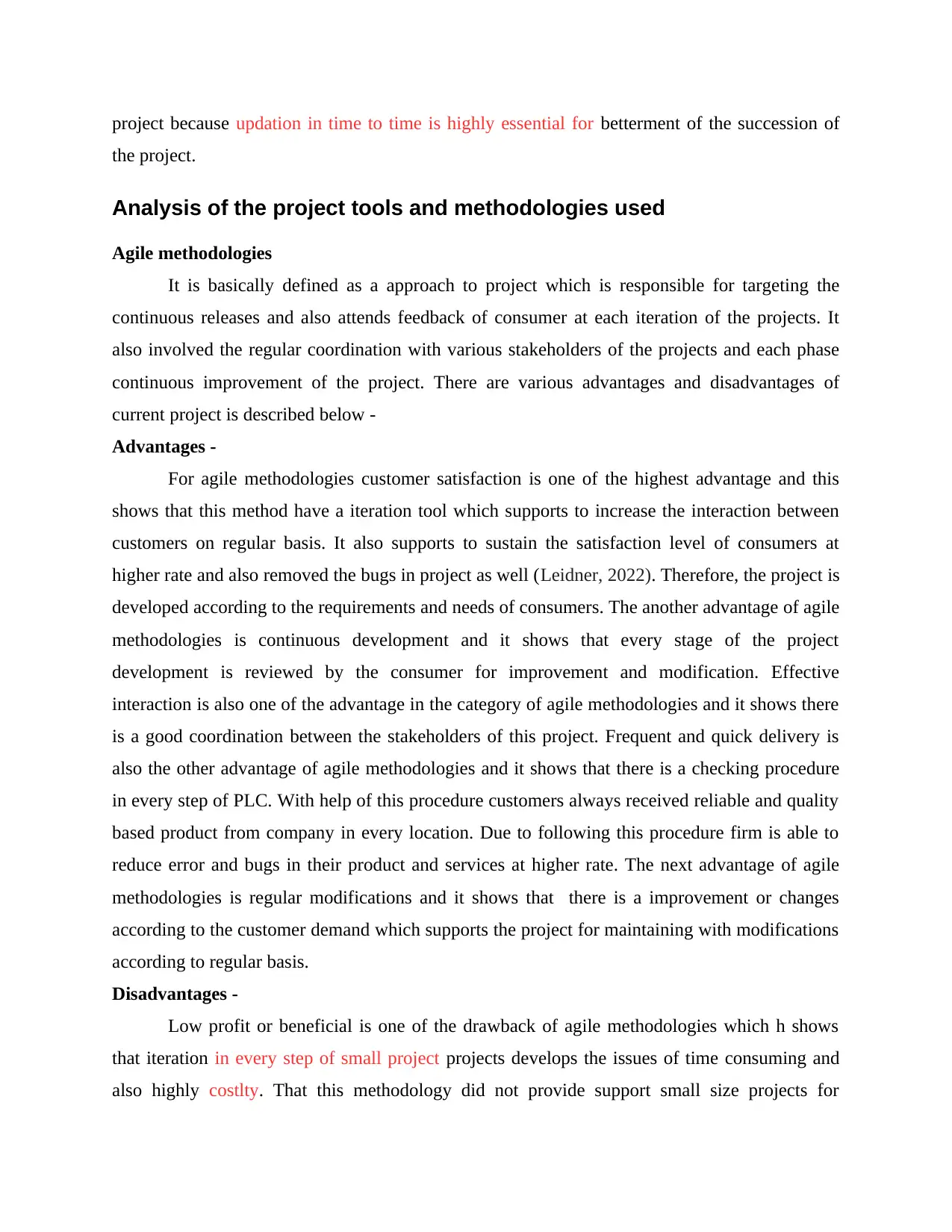
project because updation in time to time is highly essential for betterment of the succession of
the project.
Analysis of the project tools and methodologies used
Agile methodologies
It is basically defined as a approach to project which is responsible for targeting the
continuous releases and also attends feedback of consumer at each iteration of the projects. It
also involved the regular coordination with various stakeholders of the projects and each phase
continuous improvement of the project. There are various advantages and disadvantages of
current project is described below -
Advantages -
For agile methodologies customer satisfaction is one of the highest advantage and this
shows that this method have a iteration tool which supports to increase the interaction between
customers on regular basis. It also supports to sustain the satisfaction level of consumers at
higher rate and also removed the bugs in project as well (Leidner, 2022). Therefore, the project is
developed according to the requirements and needs of consumers. The another advantage of agile
methodologies is continuous development and it shows that every stage of the project
development is reviewed by the consumer for improvement and modification. Effective
interaction is also one of the advantage in the category of agile methodologies and it shows there
is a good coordination between the stakeholders of this project. Frequent and quick delivery is
also the other advantage of agile methodologies and it shows that there is a checking procedure
in every step of PLC. With help of this procedure customers always received reliable and quality
based product from company in every location. Due to following this procedure firm is able to
reduce error and bugs in their product and services at higher rate. The next advantage of agile
methodologies is regular modifications and it shows that there is a improvement or changes
according to the customer demand which supports the project for maintaining with modifications
according to regular basis.
Disadvantages -
Low profit or beneficial is one of the drawback of agile methodologies which h shows
that iteration in every step of small project projects develops the issues of time consuming and
also highly costlty. That this methodology did not provide support small size projects for
the project.
Analysis of the project tools and methodologies used
Agile methodologies
It is basically defined as a approach to project which is responsible for targeting the
continuous releases and also attends feedback of consumer at each iteration of the projects. It
also involved the regular coordination with various stakeholders of the projects and each phase
continuous improvement of the project. There are various advantages and disadvantages of
current project is described below -
Advantages -
For agile methodologies customer satisfaction is one of the highest advantage and this
shows that this method have a iteration tool which supports to increase the interaction between
customers on regular basis. It also supports to sustain the satisfaction level of consumers at
higher rate and also removed the bugs in project as well (Leidner, 2022). Therefore, the project is
developed according to the requirements and needs of consumers. The another advantage of agile
methodologies is continuous development and it shows that every stage of the project
development is reviewed by the consumer for improvement and modification. Effective
interaction is also one of the advantage in the category of agile methodologies and it shows there
is a good coordination between the stakeholders of this project. Frequent and quick delivery is
also the other advantage of agile methodologies and it shows that there is a checking procedure
in every step of PLC. With help of this procedure customers always received reliable and quality
based product from company in every location. Due to following this procedure firm is able to
reduce error and bugs in their product and services at higher rate. The next advantage of agile
methodologies is regular modifications and it shows that there is a improvement or changes
according to the customer demand which supports the project for maintaining with modifications
according to regular basis.
Disadvantages -
Low profit or beneficial is one of the drawback of agile methodologies which h shows
that iteration in every step of small project projects develops the issues of time consuming and
also highly costlty. That this methodology did not provide support small size projects for
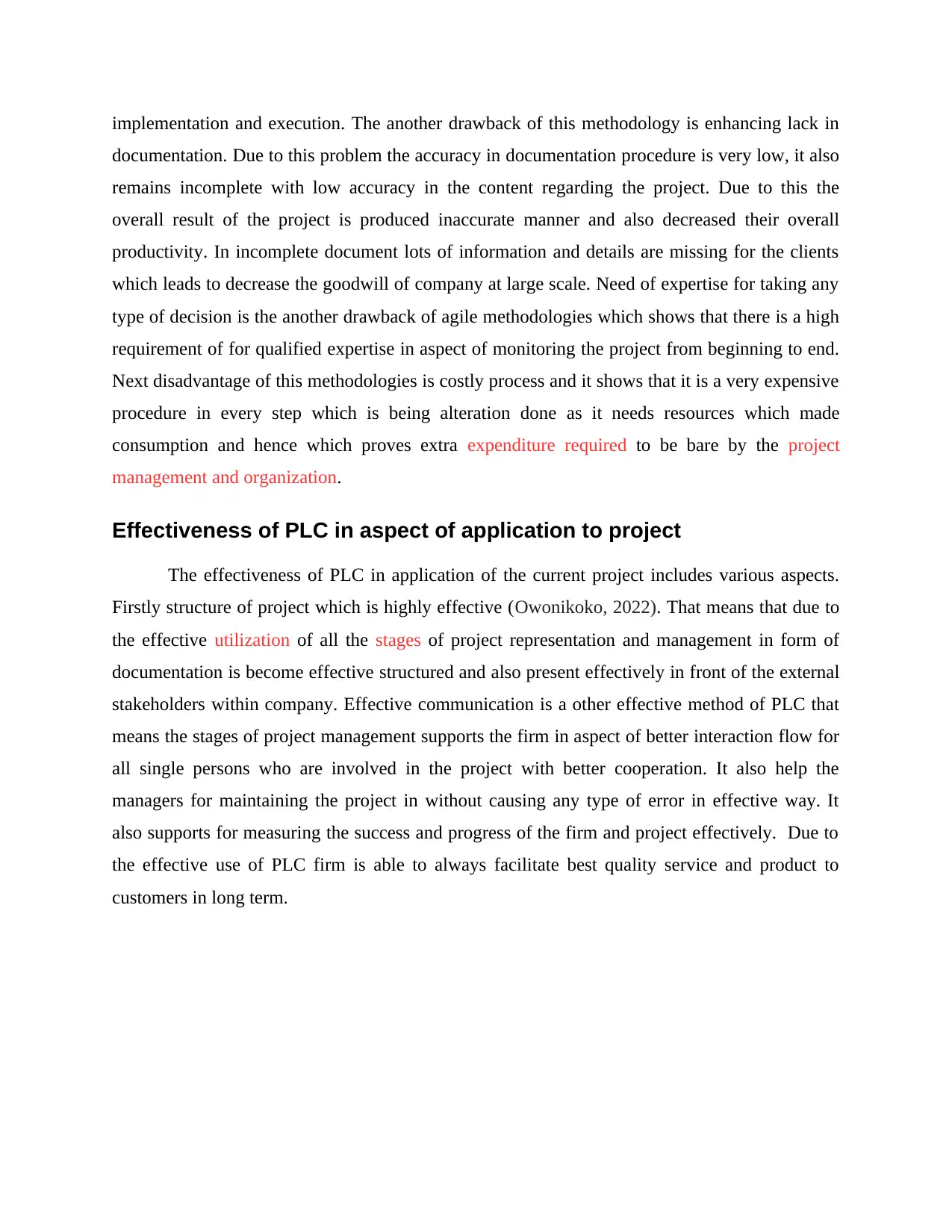
implementation and execution. The another drawback of this methodology is enhancing lack in
documentation. Due to this problem the accuracy in documentation procedure is very low, it also
remains incomplete with low accuracy in the content regarding the project. Due to this the
overall result of the project is produced inaccurate manner and also decreased their overall
productivity. In incomplete document lots of information and details are missing for the clients
which leads to decrease the goodwill of company at large scale. Need of expertise for taking any
type of decision is the another drawback of agile methodologies which shows that there is a high
requirement of for qualified expertise in aspect of monitoring the project from beginning to end.
Next disadvantage of this methodologies is costly process and it shows that it is a very expensive
procedure in every step which is being alteration done as it needs resources which made
consumption and hence which proves extra expenditure required to be bare by the project
management and organization.
Effectiveness of PLC in aspect of application to project
The effectiveness of PLC in application of the current project includes various aspects.
Firstly structure of project which is highly effective (Owonikoko, 2022). That means that due to
the effective utilization of all the stages of project representation and management in form of
documentation is become effective structured and also present effectively in front of the external
stakeholders within company. Effective communication is a other effective method of PLC that
means the stages of project management supports the firm in aspect of better interaction flow for
all single persons who are involved in the project with better cooperation. It also help the
managers for maintaining the project in without causing any type of error in effective way. It
also supports for measuring the success and progress of the firm and project effectively. Due to
the effective use of PLC firm is able to always facilitate best quality service and product to
customers in long term.
documentation. Due to this problem the accuracy in documentation procedure is very low, it also
remains incomplete with low accuracy in the content regarding the project. Due to this the
overall result of the project is produced inaccurate manner and also decreased their overall
productivity. In incomplete document lots of information and details are missing for the clients
which leads to decrease the goodwill of company at large scale. Need of expertise for taking any
type of decision is the another drawback of agile methodologies which shows that there is a high
requirement of for qualified expertise in aspect of monitoring the project from beginning to end.
Next disadvantage of this methodologies is costly process and it shows that it is a very expensive
procedure in every step which is being alteration done as it needs resources which made
consumption and hence which proves extra expenditure required to be bare by the project
management and organization.
Effectiveness of PLC in aspect of application to project
The effectiveness of PLC in application of the current project includes various aspects.
Firstly structure of project which is highly effective (Owonikoko, 2022). That means that due to
the effective utilization of all the stages of project representation and management in form of
documentation is become effective structured and also present effectively in front of the external
stakeholders within company. Effective communication is a other effective method of PLC that
means the stages of project management supports the firm in aspect of better interaction flow for
all single persons who are involved in the project with better cooperation. It also help the
managers for maintaining the project in without causing any type of error in effective way. It
also supports for measuring the success and progress of the firm and project effectively. Due to
the effective use of PLC firm is able to always facilitate best quality service and product to
customers in long term.
Paraphrase This Document
Need a fresh take? Get an instant paraphrase of this document with our AI Paraphraser
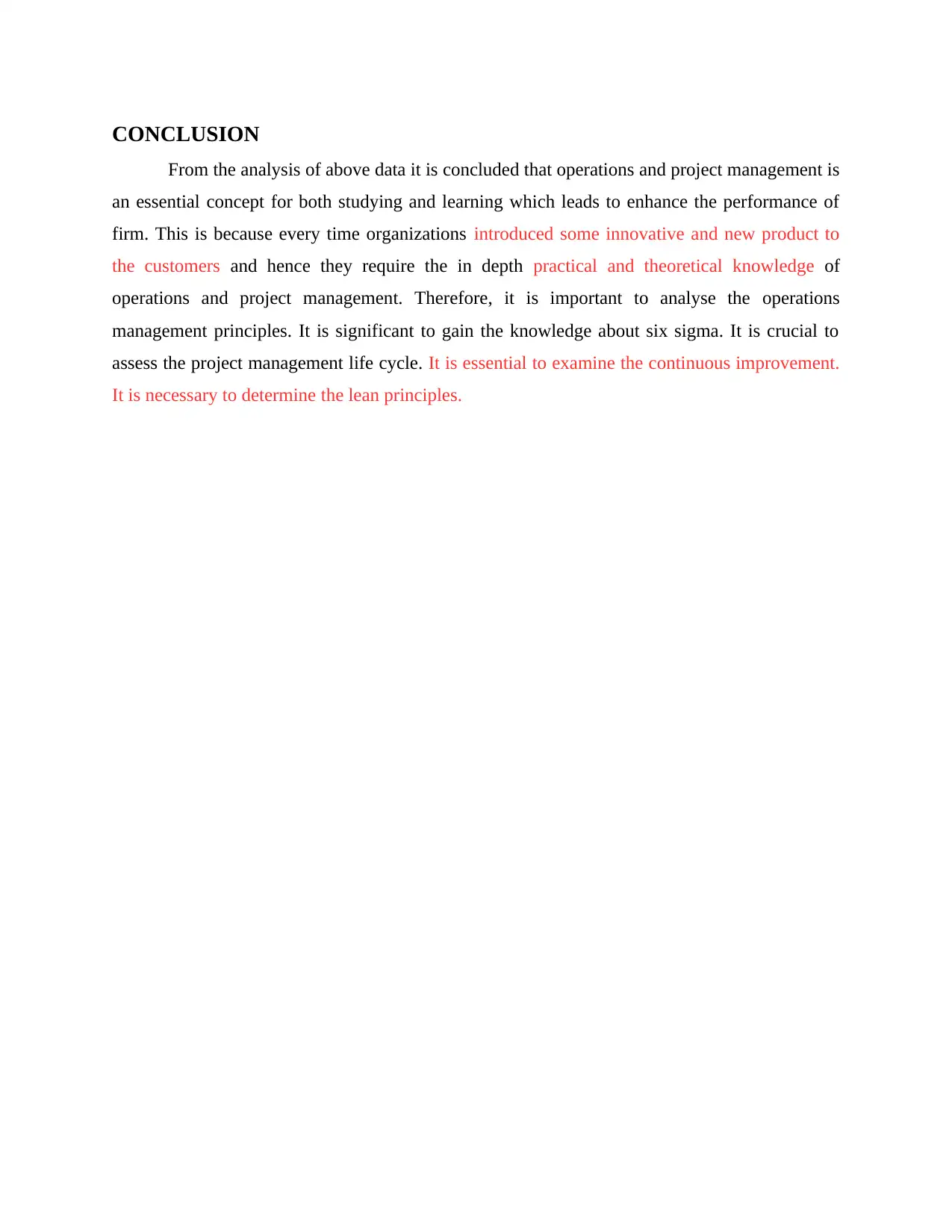
CONCLUSION
From the analysis of above data it is concluded that operations and project management is
an essential concept for both studying and learning which leads to enhance the performance of
firm. This is because every time organizations introduced some innovative and new product to
the customers and hence they require the in depth practical and theoretical knowledge of
operations and project management. Therefore, it is important to analyse the operations
management principles. It is significant to gain the knowledge about six sigma. It is crucial to
assess the project management life cycle. It is essential to examine the continuous improvement.
It is necessary to determine the lean principles.
From the analysis of above data it is concluded that operations and project management is
an essential concept for both studying and learning which leads to enhance the performance of
firm. This is because every time organizations introduced some innovative and new product to
the customers and hence they require the in depth practical and theoretical knowledge of
operations and project management. Therefore, it is important to analyse the operations
management principles. It is significant to gain the knowledge about six sigma. It is crucial to
assess the project management life cycle. It is essential to examine the continuous improvement.
It is necessary to determine the lean principles.
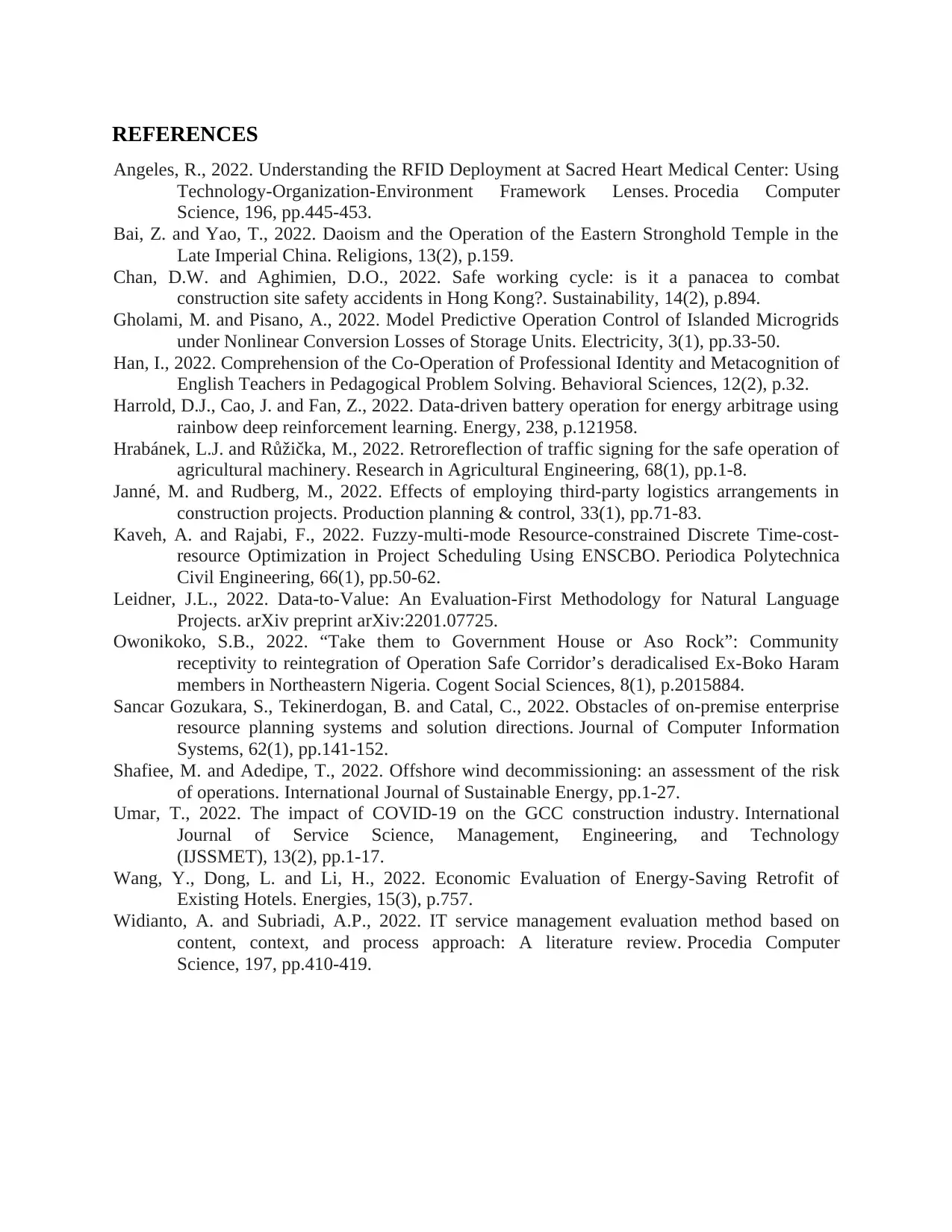
REFERENCES
Angeles, R., 2022. Understanding the RFID Deployment at Sacred Heart Medical Center: Using
Technology-Organization-Environment Framework Lenses. Procedia Computer
Science, 196, pp.445-453.
Bai, Z. and Yao, T., 2022. Daoism and the Operation of the Eastern Stronghold Temple in the
Late Imperial China. Religions, 13(2), p.159.
Chan, D.W. and Aghimien, D.O., 2022. Safe working cycle: is it a panacea to combat
construction site safety accidents in Hong Kong?. Sustainability, 14(2), p.894.
Gholami, M. and Pisano, A., 2022. Model Predictive Operation Control of Islanded Microgrids
under Nonlinear Conversion Losses of Storage Units. Electricity, 3(1), pp.33-50.
Han, I., 2022. Comprehension of the Co-Operation of Professional Identity and Metacognition of
English Teachers in Pedagogical Problem Solving. Behavioral Sciences, 12(2), p.32.
Harrold, D.J., Cao, J. and Fan, Z., 2022. Data-driven battery operation for energy arbitrage using
rainbow deep reinforcement learning. Energy, 238, p.121958.
Hrabánek, L.J. and Růžička, M., 2022. Retroreflection of traffic signing for the safe operation of
agricultural machinery. Research in Agricultural Engineering, 68(1), pp.1-8.
Janné, M. and Rudberg, M., 2022. Effects of employing third-party logistics arrangements in
construction projects. Production planning & control, 33(1), pp.71-83.
Kaveh, A. and Rajabi, F., 2022. Fuzzy-multi-mode Resource-constrained Discrete Time-cost-
resource Optimization in Project Scheduling Using ENSCBO. Periodica Polytechnica
Civil Engineering, 66(1), pp.50-62.
Leidner, J.L., 2022. Data-to-Value: An Evaluation-First Methodology for Natural Language
Projects. arXiv preprint arXiv:2201.07725.
Owonikoko, S.B., 2022. “Take them to Government House or Aso Rock”: Community
receptivity to reintegration of Operation Safe Corridor’s deradicalised Ex-Boko Haram
members in Northeastern Nigeria. Cogent Social Sciences, 8(1), p.2015884.
Sancar Gozukara, S., Tekinerdogan, B. and Catal, C., 2022. Obstacles of on-premise enterprise
resource planning systems and solution directions. Journal of Computer Information
Systems, 62(1), pp.141-152.
Shafiee, M. and Adedipe, T., 2022. Offshore wind decommissioning: an assessment of the risk
of operations. International Journal of Sustainable Energy, pp.1-27.
Umar, T., 2022. The impact of COVID-19 on the GCC construction industry. International
Journal of Service Science, Management, Engineering, and Technology
(IJSSMET), 13(2), pp.1-17.
Wang, Y., Dong, L. and Li, H., 2022. Economic Evaluation of Energy-Saving Retrofit of
Existing Hotels. Energies, 15(3), p.757.
Widianto, A. and Subriadi, A.P., 2022. IT service management evaluation method based on
content, context, and process approach: A literature review. Procedia Computer
Science, 197, pp.410-419.
Angeles, R., 2022. Understanding the RFID Deployment at Sacred Heart Medical Center: Using
Technology-Organization-Environment Framework Lenses. Procedia Computer
Science, 196, pp.445-453.
Bai, Z. and Yao, T., 2022. Daoism and the Operation of the Eastern Stronghold Temple in the
Late Imperial China. Religions, 13(2), p.159.
Chan, D.W. and Aghimien, D.O., 2022. Safe working cycle: is it a panacea to combat
construction site safety accidents in Hong Kong?. Sustainability, 14(2), p.894.
Gholami, M. and Pisano, A., 2022. Model Predictive Operation Control of Islanded Microgrids
under Nonlinear Conversion Losses of Storage Units. Electricity, 3(1), pp.33-50.
Han, I., 2022. Comprehension of the Co-Operation of Professional Identity and Metacognition of
English Teachers in Pedagogical Problem Solving. Behavioral Sciences, 12(2), p.32.
Harrold, D.J., Cao, J. and Fan, Z., 2022. Data-driven battery operation for energy arbitrage using
rainbow deep reinforcement learning. Energy, 238, p.121958.
Hrabánek, L.J. and Růžička, M., 2022. Retroreflection of traffic signing for the safe operation of
agricultural machinery. Research in Agricultural Engineering, 68(1), pp.1-8.
Janné, M. and Rudberg, M., 2022. Effects of employing third-party logistics arrangements in
construction projects. Production planning & control, 33(1), pp.71-83.
Kaveh, A. and Rajabi, F., 2022. Fuzzy-multi-mode Resource-constrained Discrete Time-cost-
resource Optimization in Project Scheduling Using ENSCBO. Periodica Polytechnica
Civil Engineering, 66(1), pp.50-62.
Leidner, J.L., 2022. Data-to-Value: An Evaluation-First Methodology for Natural Language
Projects. arXiv preprint arXiv:2201.07725.
Owonikoko, S.B., 2022. “Take them to Government House or Aso Rock”: Community
receptivity to reintegration of Operation Safe Corridor’s deradicalised Ex-Boko Haram
members in Northeastern Nigeria. Cogent Social Sciences, 8(1), p.2015884.
Sancar Gozukara, S., Tekinerdogan, B. and Catal, C., 2022. Obstacles of on-premise enterprise
resource planning systems and solution directions. Journal of Computer Information
Systems, 62(1), pp.141-152.
Shafiee, M. and Adedipe, T., 2022. Offshore wind decommissioning: an assessment of the risk
of operations. International Journal of Sustainable Energy, pp.1-27.
Umar, T., 2022. The impact of COVID-19 on the GCC construction industry. International
Journal of Service Science, Management, Engineering, and Technology
(IJSSMET), 13(2), pp.1-17.
Wang, Y., Dong, L. and Li, H., 2022. Economic Evaluation of Energy-Saving Retrofit of
Existing Hotels. Energies, 15(3), p.757.
Widianto, A. and Subriadi, A.P., 2022. IT service management evaluation method based on
content, context, and process approach: A literature review. Procedia Computer
Science, 197, pp.410-419.

Secure Best Marks with AI Grader
Need help grading? Try our AI Grader for instant feedback on your assignments.

1 out of 17
Related Documents
Your All-in-One AI-Powered Toolkit for Academic Success.
+13062052269
info@desklib.com
Available 24*7 on WhatsApp / Email
![[object Object]](/_next/static/media/star-bottom.7253800d.svg)
Unlock your academic potential
© 2024 | Zucol Services PVT LTD | All rights reserved.


